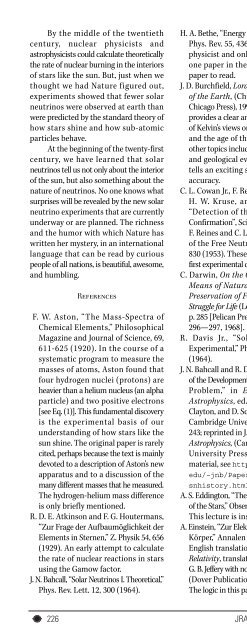I N S I D E T H I S I S S U E
insidethisissue - The Royal Astronomical Society of Canada
insidethisissue - The Royal Astronomical Society of Canada
- No tags were found...
You also want an ePaper? Increase the reach of your titles
YUMPU automatically turns print PDFs into web optimized ePapers that Google loves.
With the increasing availability of inexpensive CCD cameras and theimproving situation with computer-IRAF resources, a new laboratoryexercise has been developed that exposes students to a variety ofinteresting and useful astronomical concepts. Assuming a homogeneousdistribution of stars and no interstellar extinction, a plot of the logarithmof the number of stars as a function of magnitude will have a slope of0.6. The students use a SBIG ST-8 (or comparable) CCD camera witha 28-mm lens to obtain a wide field 10 second exposure of the nightsky. After downloading this image into IRAF, DAOFIND is used to dothe photometry to illustrate the relationship between the magnitudeof the stars and the number of stars visible. When the students comparetheir results to the expected slope of 0.6, they find that it is significantlysmaller. Discussion of this discrepancy illuminates the error in theassumptions. The same data can be used to crudely establish the centrallocation of a cluster of stars. This exercise is useful at the first-or-secondyearastronomy undergraduate level.Diffuse Molecular Gas in the Milky Way, K. A. Douglas and A. R. Taylor,University of CalgaryObservations of the gas and dust content of high-latitude gas cloudshave shown interesting relationships between the emission by thedifferent constituents of these structures. Several studies comparingIRAS, H i and CO emission in these cirrus clouds have yielded evidenceof a molecular component which is not traced by the emission of COmolecules (Reach et al. 1994, ApJ, 429, 672; Meyerdierks & Heithausen1996, AA, 313, 929; Boulanger et al. 1998, AA, 332, 273). Infrared excessemission from IRAS data points to the possibility of a molecular gascomponent that is warmer and more diffuse than the component ofmolecular gas that is traceable by CO. In these studies, the “diffuse”component of molecular hydrogen is found to be comparable in massto the H i content. This diffuse gas may be widely abundant in theplane of the Galaxy. If present, on the same scales as in these highlatitude clouds, it has important implications for many areas ofastrophysical interest. The Canadian Galactic Plane Survey (CGPS)offers an excellent opportunity to study the phenomenon of diffusemolecular gas in the plane of the Galaxy by combined analysis of pcscaleresolution images of CO, H i and dust emission over a large areaof the Galactic disk.A FUSE Survey of O vi in the Winds of LMC O Stars, A. W. Fullerton,University of Victoria/Johns Hopkins University, D. L. Massa, RaytheonITSS, and J. B. Hutchings, DAO/HIA/NRCHigh-resolution FUSE spectra of stellar wind profiles in the O viresonance doublet are presented for a sample of O stars in the LargeMagellanic Cloud. This transition is the best diagnostic of high-energyprocesses in the optical/UV range. It is present in the winds of all thestars in the sample, which cover spectral classes from O3 to B0.5 withemphasis on luminosity classes I–III. The strength and morphologyof the P Cygni profiles change systematically along the temperaturesequence: early types exhibit pronounced emission lobes, while latertypes show weaker emission but comparatively strong absorption athigh velocity. This morphology suggests that the distribution of O viions is concentrated towards larger wind velocities, particularly for thelater spectral types. Work is underway to quantify this distribution, inorder to constrain the properties of the ensembles of embedded shocksthat are the likely production mechanism for O vi.Revisiting the Classics, R.F. Garrison, Christopher Capobianco andCristina Fayet, David Dunlap Observatory, University of TorontoThe set of classical shell stars studied by Gulliver in the mid-1970s andby Merrill in the 1930s, 40s and 50s has been re-observed. The observationsand reductions were carried out by two undergraduate students aspart of a second-year, Research Opportunities Program at the Universityof Toronto. Shell stars have a wide variety of characteristics, which varyunpredictably, but with a characteristic timescale of the order of decades.A great deal can be learned by occasional monitoring of their spectra.This has not been done systematically since Gulliver’s work. The 1.88-m telescope of the David Dunlap Observatory was used with theCassegrain spectrograph and 1024 × 1024 CCD. The resulting twopixelresolution is about one angstrom. Description of the current shellcharacteristics is given.The Karma Astronomical Visualisation Software, R. Gooch, Universityof CalgaryModern astronomical instruments are producing larger and largerquantities of data. New techniques are required to visualise and analysethese data. This poster discusses the Karma visualisation software(available for free down-load from http://www.atnf.csiro.au/karma/), which addresses these needs. The Karma visualisationsoftware contains a set of programming libraries which provide acommon infrastructure for a suite of visualisation tools. This designeases development of new visualisation tools and results in tools witha common user interface. A few features of this package are: supportfor a large variety of data formats, such as FITS, Miriad, GIPSY, DRAO,AIPS, AIPS++, Starlink and common image formats such as PPM, GIF,TIFF and so on, support for compressed data files and sub-samplingupon read support for astronomical co-ordinate systems (conventionalFITS-style and DSS projections), including the ability to overlay imageswith different projections, pixel scales and rotations, linear, squarerootand logarithmic intensity transformations, output PostScript andPPM for publication and output of FITS, Miriad and GIPSY for subsampledor computed datasets, axis labelling and user control ofannotations, fully interactive zooming, panning and magnification,built-in analysis features (spectral, summed and radial profiles, Gaussianfitting, image statistics, moment maps, etc.) and much, much more.Karma comes with many specialised visualisation tools, some of whichare displayed in this poster.BD+61 2213: An Early-type Binary System in the Open Cluster NGC 7160,D. E. Holmgren, Brandon University, and A. E. Tarasov, CrimeanAstrophysical ObservatoryNew spectral data and orbital parameters are presented for the shortperiod(P = 1.2 d) B3 binary system BD+61 2213. This star is a memberof the open cluster NGC 7160. On the basis of a spectroscopic orbitand component line profiles (He i 6678 Å and H) recovered from aspectral disentangling solution, we find primary and secondary minimum248JRASC December / décembre 2000
















